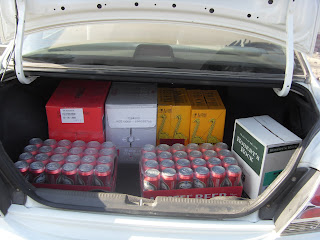Given that Colombo has little to recommend it, why then so far so very, very good? That is because of the hotel. I would go as far as to venture that Colombo would probably be worth giving a miss entirely were we not staying at the Galle Face Hotel. As it is, we will indubitably be back. The Galle Face Hotel is the oldest hotel in Asia. The oldest hotel, in fact, east of Suez. It was founded in 1864, 46 years before Singapore’s Raffles, 64 years before Hong Kong’s Peninsula and 23 years before Conrad Hilton was even born.
The Galle Face Hotel seen from it's swimming pool.
The view from our hotel window.
Rachel and I taking tea on the verandah. Note the colonial moustache.
The view from the verandah.
The verandah.
The rest of Colombo is…well to be honest, we have rarely left the hotel. We went up to the station to book our train to Kandy (£1.80 each for the best seats in the first class observation carriage – I’ll let you know what it’s like anon). We also made a sortie out towards the National Museum this morning, but Rachel came down with food poisoning (not the fish restaurant! We suspect the water) so we returned. I went out alone to the mother of all factory surplus shops, intending just to have a look round. I came back with 4 suits (Dunhill, Armani, Boss and Valentino) and 7 shirts (Paul Smith, Ermenegildo Zegna and others) which I assumed were knock offs. But, apparently, the shop is world famous and 99% of its stock is real factory surplus/seconds.
My new suits.
Him: it is a special one day festival!
Me: I’ve been.
Him: No! This is a Hindu festival. The one you went to was a Buddhist festival.
Me: I’m short of time (I had reached the cash point that I was heading for, 100 yards from the hotel)
Him: Don’t go to that cash point. I will show you a better one.
Me: Better how?
Him: That one gives you Indian money. No good, you can’t spend it. I will show you a Sri Lankan cashpoint.
Needless to say, the money was fine. Another favourite is them telling you that you can’t go a certain way because of security checkpoints. All lies! The only one that worked was a Bajaj driver (three wheeled moped taxis, like TucTucs in Thailand) who told me I should visit a shop on the way to where I wanted to go. I asked him why and he told me that if I did the shop owner would give him a litre of petrol and he was very poor. More examples of honest Sri Lankan advertising:
In case you can't read the strap line, it says "because it is really good"
And some not so honest naming of a hotel:
The thing that I suspect will most evoke our visit to Colombo will be the sound of crows. Previously their raucous cawing reminded me of the beginning of Worzel Gummidge, but it seems that the whole of the city of Colombo is given over to them. The hotel employs a man to stand on the terrace with a canvas strap to make cracking noises to scre them off. It is also the first time I have ever seen urban scarecrows:
The final footnote to all this is the cost. Rachel and I are very much economic tourists and the strength of the Western and Dubaian economy (don’t believe everything in the news!) means we can afford holidays like this, and feel OK about spreading some of our relative wealth around poorer countries. The hotel is £50 a night. The fish restaurant (one of the most expensive in the city) was £9 each. High tea on the verandah, £4. My designer suits cost £40 each and the shirts were £5 apiece.
Cheers!



























